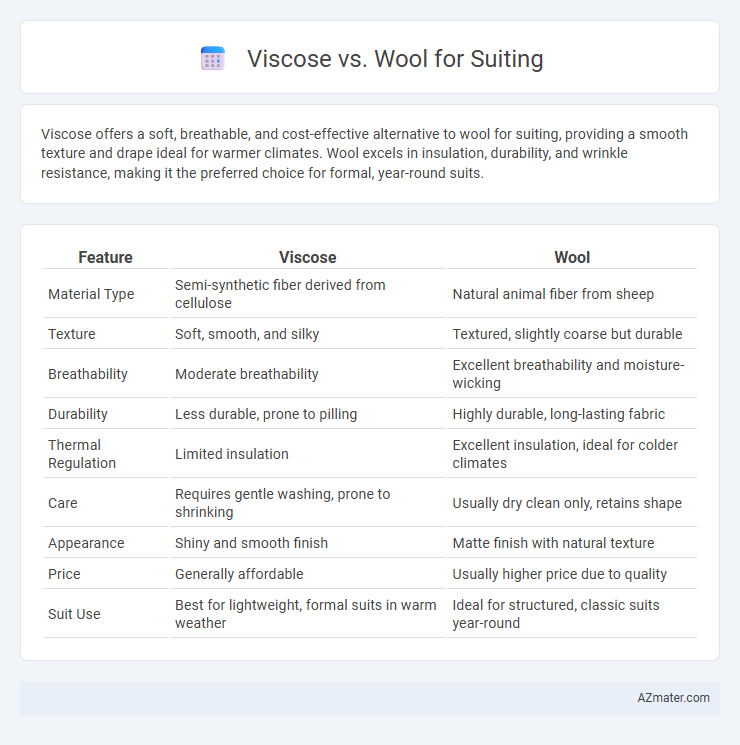Viscose offers a soft, breathable, and cost-effective alternative to wool for suiting, providing a smooth texture and drape ideal for warmer climates. Wool excels in insulation, durability, and wrinkle resistance, making it the preferred choice for formal, year-round suits.
Table of Comparison
| Feature | Viscose | Wool |
|---|---|---|
| Material Type | Semi-synthetic fiber derived from cellulose | Natural animal fiber from sheep |
| Texture | Soft, smooth, and silky | Textured, slightly coarse but durable |
| Breathability | Moderate breathability | Excellent breathability and moisture-wicking |
| Durability | Less durable, prone to pilling | Highly durable, long-lasting fabric |
| Thermal Regulation | Limited insulation | Excellent insulation, ideal for colder climates |
| Care | Requires gentle washing, prone to shrinking | Usually dry clean only, retains shape |
| Appearance | Shiny and smooth finish | Matte finish with natural texture |
| Price | Generally affordable | Usually higher price due to quality |
| Suit Use | Best for lightweight, formal suits in warm weather | Ideal for structured, classic suits year-round |
Introduction: Understanding Viscose and Wool
Viscose is a semi-synthetic fiber made from regenerated cellulose, known for its smooth texture and breathability, making it a popular choice in suiting for warmer climates. Wool, a natural protein fiber obtained from sheep, offers excellent insulation, durability, and wrinkle resistance, ideal for colder weather and formal occasions. Understanding the distinct properties of viscose and wool helps in selecting the appropriate fabric for comfort, style, and performance in tailored suits.
Key Differences Between Viscose and Wool
Viscose and wool differ significantly in fiber origin and performance, with viscose derived from regenerated cellulose fibers and wool sourced from animal hair, primarily sheep. Wool suits offer natural insulation, moisture-wicking, and durability, maintaining warmth and breathability, while viscose provides a silk-like feel, lightweight comfort, and good drape but lacks the insulating properties of wool. Key differences also include wool's superior wrinkle resistance and elasticity compared to viscose, which tends to crease more easily and requires careful laundering.
Comfort and Feel: Which Fabric Suits You Best?
Viscose offers a smooth, silky texture that is lightweight and breathable, making it ideal for warm climates or those seeking a soft feel against the skin. Wool provides natural insulation, moisture-wicking capabilities, and elasticity, delivering warmth and comfort in cooler temperatures while maintaining a structured fit. Choosing between viscose and wool depends on your climate preferences and desired balance of softness versus thermal regulation in suiting fabric.
Durability: Wool vs Viscose Longevity
Wool offers superior durability for suiting due to its natural resilience and ability to maintain shape over time, making it a long-lasting fabric choice. Viscose, while soft and breathable, tends to wear out faster with repeated use and is more prone to pilling and fiber breakdown. Choosing wool ensures greater longevity in suit durability, especially for frequent wear and professional settings.
Breathability and Moisture Management
Viscose suits offer excellent breathability due to their semi-synthetic cellulose fibers, allowing air circulation and moisture wicking, which helps keep the wearer cool and dry. Wool suits naturally regulate temperature through their crimped fibers, providing superior moisture management by absorbing up to 30% of its weight in moisture without feeling damp, making them ideal for varying climates. While viscose is lighter and more breathable, wool excels in maintaining comfort by effectively managing humidity and preventing overheating.
Maintenance and Care Requirements
Viscose suits require gentle handling, often needing dry cleaning to maintain fabric integrity and prevent shrinking, while wool suits benefit from careful brushing and occasional professional cleaning to retain natural oils and shape. Viscose is more prone to wrinkling and damage from moisture, necessitating cautious storage and minimal exposure to water. Wool provides better durability and resilience, often allowing for spot cleaning and air drying without compromising the garment's lifespan.
Cost Comparison: Viscose Suits vs Wool Suits
Viscose suits generally cost significantly less than wool suits, making them a budget-friendly option for suiting. Wool suits, especially those made from high-quality merino or cashmere blends, tend to be pricier due to the natural fiber's durability and insulation properties. While viscose offers affordability and a smooth texture, wool provides superior breathability and longevity, justifying the higher investment for long-term wear.
Sustainability and Environmental Impact
Viscose, derived from cellulose fibers, involves chemically intensive processes that contribute to deforestation and water pollution, raising sustainability concerns in suiting fabric production. Wool, a natural protein fiber, offers biodegradability and renewable qualities, but its environmental footprint varies based on animal farming practices, including greenhouse gas emissions and land use. Choosing sustainable suiting requires evaluating production methods, resource consumption, and potential for recycling or biodegradation between viscose and wool fabrics.
Style and Appearance: Visual Appeal of Each Fabric
Viscose offers a smooth, silky sheen that enhances the drape and flow of suits, creating a refined and polished look suitable for formal and lightweight attire. Wool boasts a natural texture with subtle variations and a matte finish that conveys warmth, depth, and classic elegance, highlighting the fabric's rich fibers and craftsmanship. While viscose provides a sleek, lustrous appearance, wool's visual appeal lies in its timeless robustness and ability to maintain shape under varying conditions.
Final Verdict: Choosing the Right Fabric for Your Suit
Viscose offers a lightweight, breathable option ideal for warm climates and affordable suiting with a smooth, silk-like finish, while wool excels in durability, insulation, and wrinkle resistance, making it perfect for year-round wear and formal occasions. The final verdict depends on climate, budget, and usage needs; wool is preferred for its classic elegance and longevity, whereas viscose suits provide comfort and affordability for casual or summer suits. Selecting the right fabric balances style, performance, and care requirements tailored to your specific suiting demands.

Infographic: Viscose vs Wool for Suiting
 azmater.com
azmater.com